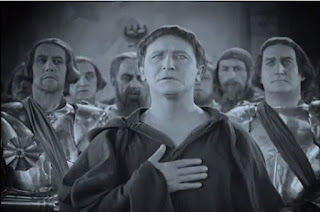A.D. (2015) - Part 4

For one thing it felt like it was this episode where the series' multi-ethnic casting really matured. It's been a key feature of course, both of A.D. The Bible Continues/Kingdom and Empire and The Bible before it, , notably the casting of black actors to play Samson and John son of Zebedee, but whilst that has been in some senses laudable, it's also felt a little forced, like a man trying to impress a woman by telling her how into feminism he is.
This time, however, it felt more natural and it started to reap the benefits. In particular it seemed like the first time that John was allowed to really emerge from being one of the twelve to being a more distinct character. He's still very much playing second fiddle to Peter, but he had a bigger role than in previous episodes.
More broadly the multi-ethnic casting gave a far more realistic feel to a busy, trade route city such as Jerusalem in an empire that extended into Africa, Asia and across most of Europe. There's a tendency as well to assume that the Jews were largely an ethnically pure race, but I'm not sure that this is much more than an assumption based on a purist extrapolation of Jewish law.
The most interesting scene in the film was that of Ananias and Sapphira (Acts 5), a story that has long held a kind of morbid fascination for me. The Bible remains curiously silent on the question of who, if anyone, killed the pair and the film does a good job of capturing this. It won't satisfy those who think that Peter murdered the pair (or ordered others to do it), but those who think his anger contributed to an underlying health issue will like the ambiguity.
What I particularly appreciated about the sequence, however, was the way it adopted aspects of the horror genre. In particular the music, special effects, reaction shots on onlookers' faces and the low camera angle of various shots gave this a real horror effect. The story feels like one of the last vestiges of the Old Testament stubbornly refusing to leave and the film makes the shocking nature of this contrast stand out. Easily the best sequence in series so far.
Elsewhere, the relationship between Pilate and Caiaphas, which annoyed me to begin with is developing in interesting ways. Where at first Caiaphas seemed to have the upper hand and be nudging Pilate into executing Jesus, now Pilate is acting in a manner far more in keeping with the thug that emerges from the various documents that describe him and Caiaphas is becoming more the sympathetic victim.
Here he's challenged by Joseph of Arimathea that if the relationship he has cultivated with Pilate means anything then it has to mean something now (that he is randomly executing young man until the man who tried to murder him is taken into custody). The result is an utter humiliation for Caiaphas meaning that this production perhaps portrays the dominance of the Roman leaders better than any other that comes immediately to mind.
Lastly, we also get to meet Barnabas in this episode. What's interesting about this is that he is portrayed as a rich man, but one who feels that the disciples judge him because of his wealth. Barnabas' line here "I'm disappointed you assume my wealth sets us apart" sounds like it is working a little too hard to accommodate the subsequent wealth of western churches with the communal sharing of wealth to help the poor that is depicted in the early chapters of Acts, but it's interesting to see how the story develops on this point. I'm actually quite looking forward to the next episode.
Labels: A.D. (NBC)


























